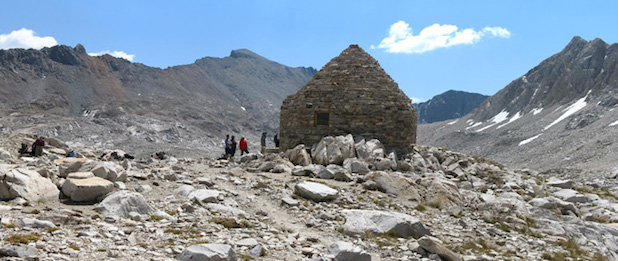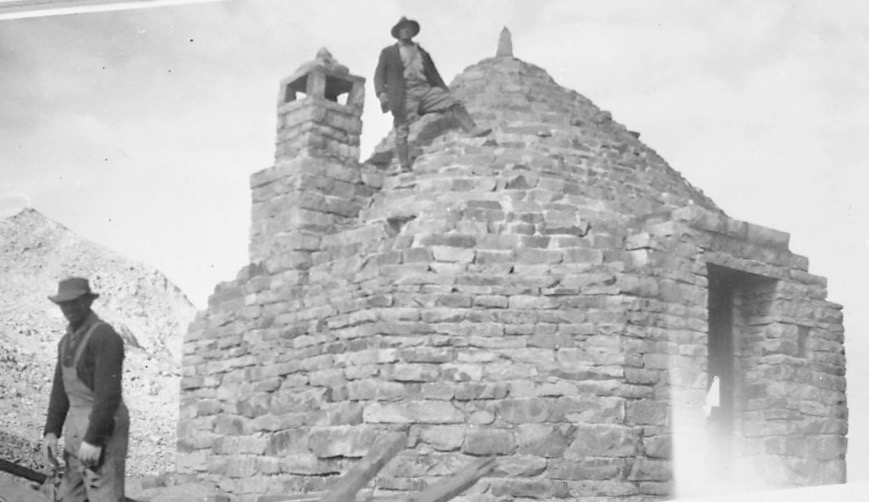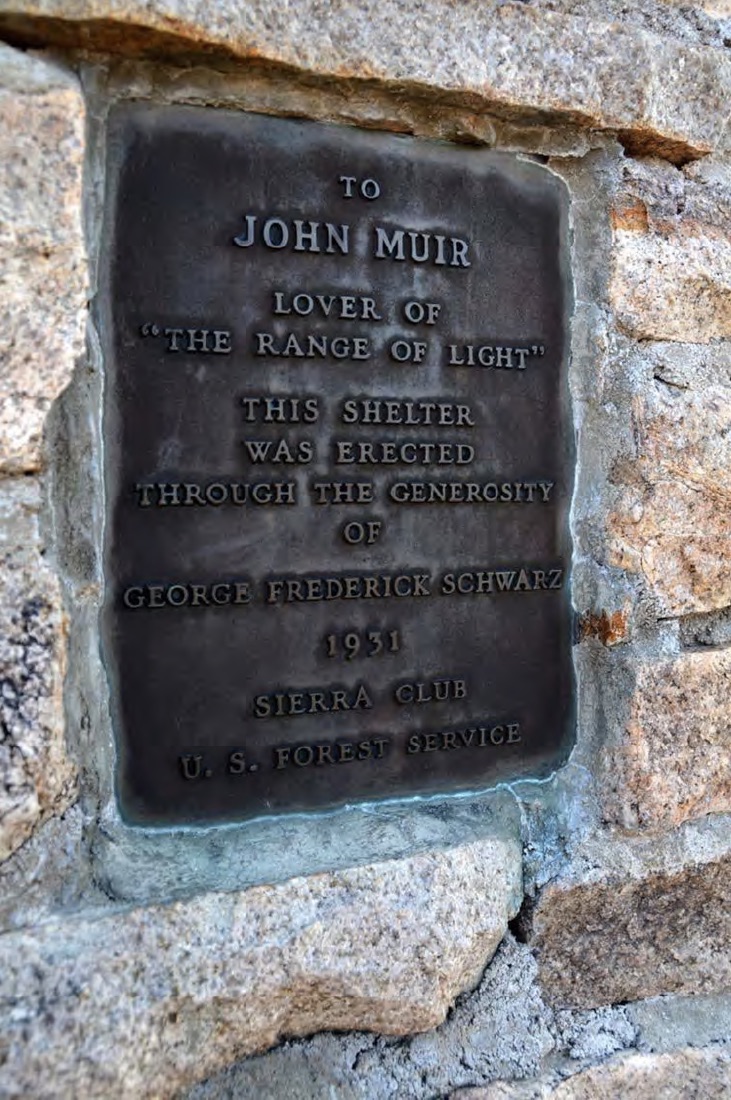the john muir exhibit - geography - california - john muir tree
John Muir Memorial Shelter
(aka "Muir Hut")
Located on Muir Pass, John Muir Trail, Kings Canyon National Park, California

Located high on the summit of Muir Pass, stands an octagonal granite structure known for many years as the "Muir Hut." The term "hut" refers to the Italian "Trullo Hut tradition" design which the architecture is modeled after. These structures (plural,
trulli), dating from as early as the mid-14th century, characteristically feature pyramidal, domed, or conical roofs built up of corbelled limestone slabs. It was constructed by the Sierra Club in 1930, and serves as both an emergency shelter and as a memorial to John Muir. The shelter is located at the proximate mid-point of the John Muir Trail (JMT) section of the Pacific Crest Trail (PCT). It stands at an elevation of 11,955 feet. It's well above treeline in a forbidding moonscape of rock. From this location, one can view two lakes named after John Muir's daughters: Wanda Lake is west of Muir Pass and Helen Lake is to the northeast. The interior is a single open chamber with a sixteen-foot high corbelled stone ceiling showing the shape of the cone-shaped roof, built-in perimeter stone seating, and a stone fireplace with raised hearth, mantel, and external chimney.
History
The John Muir Memorial Shelter was conceived by William E. Colby and designed by Berkeley architect Henry Gutterson. Colby worked for the Sierra Club for more than sixty years in various capacities including lawyer, director, recording secretary, outings leader, president, and supporter. He is credited with beginning the Club's annual hiking or "High Trips" that initiated their outing programs and became the training ground for emerging club leaders. Colby contributed substantially to the establishment of Kings Canyon and other national parks in the west, as well as to the California State Parks System, and was the first recipient of the Sierra Club's John Muir Award in 1961 Architect Henry Gutterson translated Colby's seminal idea into buildable architectural form at a ~12,000 foot high Sierra Nevada elevation.
Inspiration for the John Muir Memorial Shelter occurred in early 1930, when the secretary of the Sierra Club William Colby opened his February, 1930 issue of National Geographic Magazine and discovered an article entitled "The Stone Beehive Homes of the Italian Heel." Impressed by the exotic vernacular stone architecture, Colby envisioned a granite version of the Trullo hut to be constructed at Muir Pass as a commemorative memorial to John Muir as well as a functional shelter for hikers and backpackers. The strategic setting at the apex of Muir Pass was intentional: to place the memorial at the proximate midpoint of the John Muir Trail in honor of Muir's contributions to the Sierra Nevada's wilderness conservation movement. Colby reported how the initial stones for the construction were actually laid out during the Sierra Club's annual High Trip in 1930, telling how the group traveled over Muir Pass, "where the site for the John Muir Memorial Rest Hut was selected, and where many willing workers piled up stones to be used in the construction later in the summer. The rugged scenery characteristic of the High Sierra seems to reach its climax at this spot, so fittingly named for John Muir."

 Recent research shows that while the structure has been known primarily as an emergency shelter, it was originally designed for the main purpose of providing a memorial to John Muir, the great naturalist and the Sierra Club's first president. It was constructed ten years before the establishment of Kings Canyon National Park, with the cooperation of the U.S. Forest Service, and was seen as a centerpiece to the John Muir Trail. The Muir Memorial Shelter is significant as the sole commemorative structure in the United States erected to pay tribute to the pioneering role played by Muir and the Sierra Club in the American conservation movement and the stewardship of natural resources.
Recent research shows that while the structure has been known primarily as an emergency shelter, it was originally designed for the main purpose of providing a memorial to John Muir, the great naturalist and the Sierra Club's first president. It was constructed ten years before the establishment of Kings Canyon National Park, with the cooperation of the U.S. Forest Service, and was seen as a centerpiece to the John Muir Trail. The Muir Memorial Shelter is significant as the sole commemorative structure in the United States erected to pay tribute to the pioneering role played by Muir and the Sierra Club in the American conservation movement and the stewardship of natural resources.
Leaders of the Sierra Club originally dedicated the memorial shelter in on July 30, 1933, during a boisterous ceremony that included speeches and musical performances, held during the club's annual high country trip. The trip report in the Sierra Club Bulletin by Ethel Boulware tells how the then-president of the Sierra Club, Francis Farquhar presided. "Following a song by Doris Barr, Mr. Glisan and Mr. Colby spoke of the world's admiration and love for John Muir. As his work is destined to carry on through the years, so, the hope was expressed, this shelter, dedicated to him may likewise serve for an untold period of time to offer protection and safety to storm-bound travelers... Appreciation was expressed for the gift of the late George Frederick Schwarz, though whose kindness the building of the hut was made possible. A bronze plaque bearing the following inscription was cemented into place: TO JOHN MUIR, LOVER OF THE RANGE OF LIGHT, THIS SHELTER WAS ERECTED THROUGH THE GENEROSITY OF GEORGE FREDERICK SCHWARZ, 1931 - SIERRA CLUB - U.S. FOREST SERICE." (Sierra Club Bulletin, Vol. XIX, No. 3, June, 1934, pg. 7.)
The original commemorative Plaque which stands outside by the entrance still remains. However, as noted below, an interior plaque which had identified the building as the "Muir Hut," with a portrait of Muir and the Sierra Club logo has been replaced.
National Historic Register Designation
In 2014, Sierra Club member Doug Harnsberger, an architect and architectural historian, began to research and write a report nominating the John Muir Memorial Shelter in Kings Canyon National Parks to the National Register of Historic Places. His efforts were successful, and the nomination was approved two years later.
In recognition of the 100th anniversary of the National Park Service, August 25, 2016, the John Muir Memorial Shelter was placed on the National Register of Historic Places by the National Park Service.
A ceremony to dedicate the addition of the Shelter to the National Register of the Historic Places and the newly-designed commemorative plaque, held on August 25, 2016, is described in this photo essay: "Trulli Inspired" by Tom Valtin (Sierra Club Planet, December 5, 2016).
See also this video of the event:
The University of California published a fine article about Doug Harnsberger's discovery of the original architectural drawings, and his effort to have the John Muir Shelter designated as a national historic site: Berkeley Alum Uncovers Mystery of John Muir's Sierra Nevada hut. The University also published the following video, entitled "Uncovering the mystique of the John Muir Shelter":
As part of the effort, anew plaque above the mantel piece was created to better identify the shelter with John Muir, and to recognize the effort of Muir's friend, William Colby, who worked to create this tribute to John Muir. Designed by Richmond, Virginia sculptor Paul DiPasquale, the plaque features John Muir facing longtime Sierra Club director William Colby, who initiated the Club's annual "High Trips" in 1901 and led his final High Trip in 1929. It was Colby's vision to build the hut, which appears between the two men on DiPasquale's bas relief. The new plaque, taken up to the Shelter in 2016, was physically installed over the fireplace mantel at the Muir Memorial Shelter on in August, 2018.
The new plaque reads: The John Muir Memorial Shelter was erected in 1930 to commemorate America's leading early conservationist and first president of the Sierra Club. Conceived by Sierra Club "High Trip" leader William Colby, inspired by the Trullo Hut building tradition, and designed by Bay Area architect Henry Gutterson, the rustic alpine shelter endures as a fitting tribute to Muir's great passion for preserving wilderness and his legacy for our national parks. August 25, 2016, National Park Service Centennial, Sierra Club."

The installation of the commemorative placque was accomplished on August 5, 2018. The National Park Service's Thor Riksheim, Historical Architect Doug Harnsberger, his daughter Giles Harnsberger and the Trulli Inspired documentary filmmaker, Julia Marshall made the passage over Lamarck Col to Muir Pass and installed the stunning bas-relief in its proper place above the fireplace of the John Muir Memorial Shelter:
Restoration Projects
The John Muir Memorial Shelter has suffered from some damage over the years. During the summer of 1985 a National Park Service work crew accomplished some much-needed granite re-pointing work. In August 2013, another [park restoration crew made carpentry repairs to the entry door and north window. They also closed off the firebox with granite fieldstone and mortar to prevent flue access by resourceful marmots, and to restrict campfires above 10,000 feet, consistent with the park's policy within Alpine Zone Wilderness.
Today, even after the historic place designation, unfortunately, the shelter's distinctive corbelled stone roof leaks significantly when it rains. Recently some surprised backpackers reported that they were forced to pitch their tents - within the stone chamber - in order to stay dry during a heavy downpour. This is not good: Rainwater is freely entering through the roof via many gaps in the aging mortar that binds the stone. ​ The historic structure needs to be made watertight again. Decaying mortar joints between each of the granite stones need to be properly excavated, cleaned and re-pointed with new mortar. The Sequoia Parks Conservancy has adopted a project to undertake the necessary "re-pointing" to restore the granite structure.
An obelisk-shaped granite finial once projected 22" above the peak of the roof. It disappeared from the roof sometime after 1960. The finial is the only original character-defining detail that has been lost since its 1930 construction. The new John Muir Trail Foundation had adopted a project to restore the Muir Shelter Finial.
A Landmark Memorial
As Doug Harnsberger states, "There's an inherent tension between those 'pre-existing' cultural resources and 'wilderness zone' landscapes in the national parks. Some feel that all man-made structures should be removed from wilderness areas. But the Muir Hut is a significant pre-existing cultural resource - already more than 50 years old when Kings Canyon National Park wilderness was established [in 1984] - and a national landmark that deserves protection as a memorial to the man who did more than anyone at the turn-of-the-20th century to protect these mountains."
The Muir Shelter remains the one and only architectural feature of this highly important cultural/natural landscape, the John Muir Trail. Its significance is integrally tied to its setting, its architecture, and to its cultural impact and association with John Muir and the Sierra Club and their seminal role in the conservation and enjoyment of national parks and wilderness areas.
Credits:
Top photo of Muir Hut courtesy of Don Furman
Historic photo of Muir Hut under construction in 1930 courtesy of U.S. National Park Service SEKI Historic photos gallery: https://npgallery.nps.gov/ SEKI/
2016 and 1933 plaque photos by Doug Harsnberger
More more images and information:
Home
| Alphabetical Index
|